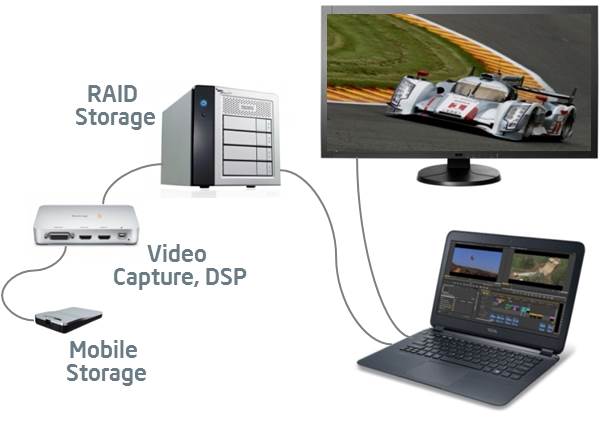Formerly known by its codename “Falcon Ridge,” the next generation of Intel’s Thunderbolt interface will officially be known as “Thunderbolt 2.” The Thunderbolt technology has become one of the standard ports for Apple computers, but has experienced slower adoption with PCs. Intel is hoping that the mainstream adoption of 4K video technologies will help drive interest in the next iteration of its high-bandwidth Thunderbolt bus.
 “Intel’s announcement blog post focuses heavily on the creation and consumption of 4K video, almost to the exclusion of everything else,” reports Ars Technica. “To that end, Thunderbolt 2 doesn’t include an increase in the total throughput the connection can provide, but it does aggregate the data channels together. Rather than four 10Gbps lanes spread across two channels, Thunderbolt 2 provides two 20Gbps lanes across one channel. This gives the bus the necessary throughput to push the required 3840 x 2160 pixels while maintaining headroom for other applications to also use the bus.”
“Intel’s announcement blog post focuses heavily on the creation and consumption of 4K video, almost to the exclusion of everything else,” reports Ars Technica. “To that end, Thunderbolt 2 doesn’t include an increase in the total throughput the connection can provide, but it does aggregate the data channels together. Rather than four 10Gbps lanes spread across two channels, Thunderbolt 2 provides two 20Gbps lanes across one channel. This gives the bus the necessary throughput to push the required 3840 x 2160 pixels while maintaining headroom for other applications to also use the bus.”
“By combining 20Gbs bandwidth with DisplayPort 1.2 support, Thunderbolt 2 creates an entirely new way of thinking about 4K workflows, specifically the ability to support raw 4K video transfer and data delivery concurrently,” says Jason Ziller, marketing director for Thunderbolt at Intel. “And our labs aren’t stopping there, as demand for video and rich data transfer just continues to rise exponentially.”
Thunderbolt users “will be able to create, edit, and view live 4K video streams delivered from a computer to a monitor over a single cable, while backing up the same file on an external drive, or series of drives, simultaneously along the same device daisy-chain,” notes the Intel blog. “Backing up terabytes of data will be a question of minutes, not hours.”
Thunderbolt 2, which Intel explains is backwards compatible, is scheduled to begin production by the end of this year.

No Comments Yet
You can be the first to comment!
Leave a comment
You must be logged in to post a comment.